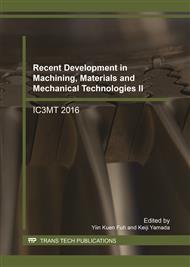p.39
p.46
p.52
p.58
p.65
p.70
p.76
p.81
p.87
Property and Recyclability Change of Corrosion-Inhibition-Improved Amine-Free Water-Soluble Cutting Fluid with Repeated Recycling
Abstract:
Cutting fluid is commonly used during metal cutting process for cooling and lubrication. Fluid types are generally classified into mineral or fatty oils and water miscible oils. In Japan, the former is called water-insoluble coolants, and the latter is called water-soluble coolants. Water-insoluble coolants are specified as dangerous material by the Japanese law due to its flammability. Therefore, the water-insoluble coolants are not appropriate for unmanned operation of machine tools. Therefore, the usage rate of water-soluble coolants is increasing. Water soluble coolants are diluted with a water by several ten times. The waste management of the water-soluble coolant become important for environment-conscious green manufacturing. We have been developing a recycling system for water-soluble coolants. In the recycle system, water is extracted from the waste coolant and the water is then reutilized as a diluent of a new coolant. We have developed various types of chemical or bio-chemical water recovery methods for recycling systems. We found a commercially available amine-free water-soluble coolant is suitable for the recycling system. The processing time, processing cost, and the biochemical and chemical oxygen demand of the extracted water are improved by the amine-free water soluble coolant compared with a conventional amine-containing coolant. However, its corrosion inhibition performance was poor in general machining applications. Our cooperative company developed a prototype of a corrosion-inhibition-improved amine-free water-soluble cutting coolant. The prototype coolant showed a good stability and cooling and lubricating performances, and its recyclability was as good as that of conventional amine-free coolants. In this study, we focused on repeated recycling of the prototype coolant. We repeatedly applied the water recycling process to the recycled coolant. The recyclability of the prototype coolant was not affected by repeated recycling; however, process residues increased with the number of recycles, and a deterioration was noticed in the corrosion-inhibition performance of the coolant diluted with recycled water.
Info:
Periodical:
Pages:
65-69
Citation:
Online since:
August 2017
Price:
Сopyright:
© 2017 Trans Tech Publications Ltd. All Rights Reserved
Share:
Citation:


